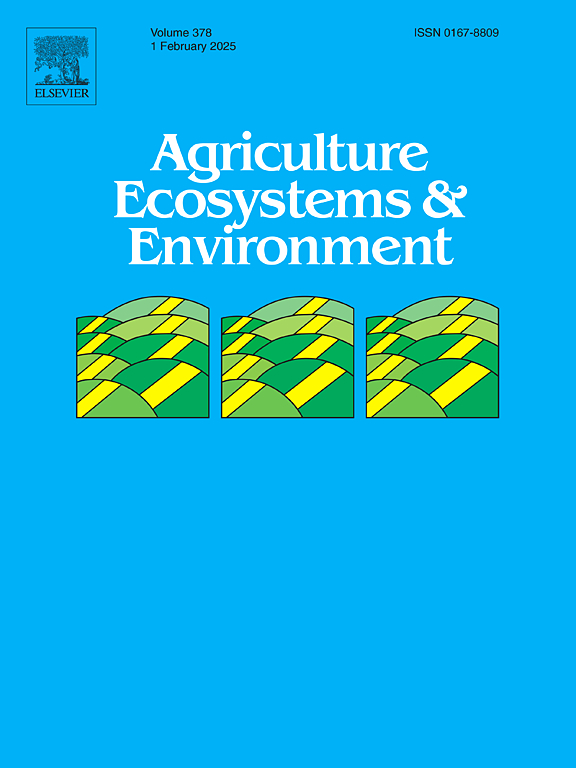在中国东部的长江三角洲,稻鸭养殖通过改变土壤磷组分来提高磷的利用和粮食产量
IF 6
1区 农林科学
Q1 AGRICULTURE, MULTIDISCIPLINARY
引用次数: 0
摘要
磷是作物必需的营养物质,对植物的生长发育起着至关重要的作用。土壤中磷的充足有效性与作物生产力和土壤健康密切相关。稻鸭综合养殖以其可持续和环保的做法而闻名。然而,这种耕作制度对土壤磷组分的具体影响及其影响作物磷利用效率(PUE)的机制需要进一步研究。在此基础上,进行了为期2年的稻鸭综合栽培试验,采用化学肥料(RDF)、70% %化学肥料和30% %有机肥料(RDFO)、有机肥料(RDO)和不施肥(RD) 4种施肥处理。无鸭对照组(水稻单作),按化肥、化肥(70% %化肥和30% %有机肥混合施用)、有机肥和不施肥处理设置。各处理间磷肥、氮肥和钾肥的投入量基本一致。结果表明,稻鸭一体化耕作制度显著提高了土壤活性磷库,从而提高了磷利用效率(PUE),最终提高了水稻产量,特别是在化学和混合施肥制度下。研究发现,鸭子的存在增加了土壤中不稳定的P组分,如树脂-P和NaHCO₃-P,它们可以直接被植物吸收。这进一步导致PUE比水稻单一栽培大幅增加。RDF在2018年和2019年分别显著增加了41.3% %和20.5% %的PUE。RDFO在2018年和2019年分别显著提高了10.9 %和26.1 %的PUE。只有在有机肥处理下,有鸭和无鸭处理对籽粒磷吸收和PUE没有显著差异。此外,RD在2018年和2019年分别显著提高了15.3 %和8.83 %的粮食产量。2019年,RDFO仅显著提高了9.6% %的粮食产量。这些结果表明了一种改善水稻种植中磷肥管理的可持续方法,可能导致更高的作物生产力和更好的PUE。进一步的长期研究,特别是在有机肥制度下,有必要探索这种综合耕作系统的潜在环境影响。本文章由计算机程序翻译,如有差异,请以英文原文为准。
Rice-duck farming enhances phosphorus use and grain yield via altering soil phosphorus fractions in the Yangtze River Delta of eastern China
Phosphorus (P) is an essential nutrient for crops, playing a critical role in plant growth and development. Adequate P availability in the soil is closely tied to crop productivity and soil health. Integrated rice-duck farming has been known for its sustainable and eco-friendly practices. However, the specific effects of this farming system on soil P fractions as well as the mechanisms by which it influences P use efficiency (PUE) by crops, require further investigation. Here, we conducted a two-years field experiment of integrated rice-ducking farming combined with four fertilizer treatments, including chemical fertilizer (RDF), a mixture of 70 % chemical and 30 % organic fertilizers (RDFO), organic fertilizer (RDO) and no fertilizer (RD). The control groups with absence of ducks (rice monoculture) were also set based on the consistent fertilizer treatments as RMF (chemical fertilizer), RMFO (a mixture of 70 % chemical and 30 % organic fertilizers), RMO (organic fertilizer) and RM (no fertilizer applied), respectively. The input of P, nitrogen and potassium fertilizer were consistent among treatments. The results demonstrate that the integrated rice-duck farming system significantly enhances soil labile phosphorus pools, thereby improving P use efficiency (PUE) and ultimately increasing rice yield, particularly under chemical and mixed fertilizer regimes. The presence of ducks was found to increase the labile P fractions in the soil, such as Resin-P and NaHCO₃-P, which are directly available to plants. This further lead to a substantial increase in PUE than rice monoculture. RDF significantly increased PUE by 41.3 % and 20.5 % in 2018 and 2019, respectively. RDFO significantly increased PUE by 10.9 % and 26.1 % in 2018 and 2019, respectively. Only under organic fertilizer treatment there was no significant difference for grain P uptake or PUE between the treatments with or without the presence of ducks. Furthermore, RD significantly improved the grain yields by 15.3 % and 8.83 % in 2018 and 2019, respectively. RDFO only significantly increased the grain yields by 9.6 % in 2019. These results demonstrate a sustainable approach to improve P fertilizer management in rice cultivation, potentially leading to higher crop productivity and better PUE. Further long-term studies, especially under organic fertilizer regimes, are necessary to explore the potential environmental impacts of this integrated farming system.
求助全文
通过发布文献求助,成功后即可免费获取论文全文。
去求助
来源期刊

Agriculture, Ecosystems & Environment
环境科学-环境科学
CiteScore
11.70
自引率
9.10%
发文量
392
审稿时长
26 days
期刊介绍:
Agriculture, Ecosystems and Environment publishes scientific articles dealing with the interface between agroecosystems and the natural environment, specifically how agriculture influences the environment and how changes in that environment impact agroecosystems. Preference is given to papers from experimental and observational research at the field, system or landscape level, from studies that enhance our understanding of processes using data-based biophysical modelling, and papers that bridge scientific disciplines and integrate knowledge. All papers should be placed in an international or wide comparative context.
 求助内容:
求助内容: 应助结果提醒方式:
应助结果提醒方式:


